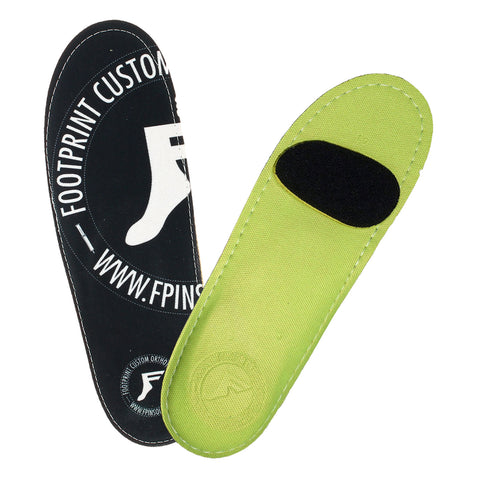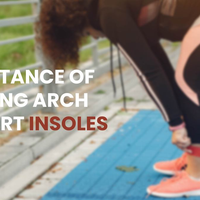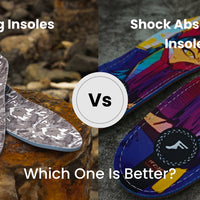Maximizing Comfort: The Science Behind Shoe Insoles

In today's society, where people are constantly on their feet, the importance of comfort cannot be overstated. Whether you're an athlete pushing your limits or someone navigating daily life, the right shoe insoles can make all the difference. But what exactly is the science behind these seemingly simple inserts? In this in-depth blog, we'll explore the intricate world of shoe insoles and uncover the science behind how they maximize comfort. Shoe insoles are designed to provide cushioning, support, and stability for your feet. They work by redistributing pressure on your feet, absorbing shock, and improving overall alignment. The anatomy of your foot plays a crucial role in determining the type of insole that will work best for you.
Let's start by understanding the different layers of a typical shoe insole. Most insoles are comprised of three main layers:
1. The top layer, also known as the "comfort layer," is usually made of soft materials like foam, gel, or fabric. This layer provides cushioning and padding to reduce pressure on the soles of your feet.
2. The middle layer, or the "support layer," is typically made of firmer materials like EVA foam or polyurethane. This layer gives structure and arch support, helping to maintain your foot's natural alignment.
3. The bottom layer, known as the "base layer," is usually made of durable materials like rubber or plastic. This layer provides stability and protects the insole from wear and tear.
The science behind how shoe insoles work lies in their ability to support the three arches of your foot: the medial longitudinal arch, the lateral longitudinal arch, and the transverse arch. These arches help distribute weight evenly across your foot and provide shock absorption during activities like walking, running, or standing for long periods.
When your feet are properly supported, your body is better able to maintain its natural alignment, reducing the risk of injuries and alleviating pain in your feet, ankles, knees, hips, and lower back. Insoles with proper arch support can also improve your posture and overall comfort.
It's important to note that not all shoe insoles are created equal. Different types of insoles are designed to address specific foot conditions, such as flat feet, high arches, plantar fasciitis, and overpronation. Custom-made insoles, prescribed by a podiatrist, offer the most personalized support for individuals with unique foot shapes and conditions.
2. Understanding Foot Mechanics
Our feet are marvels of engineering, comprising intricate networks of bones, muscles, ligaments, and tendons. They serve as the foundation for our entire body, absorbing shock and supporting our weight with every step we take. Any deviation from proper alignment or imbalance can lead to discomfort and potential injury. It is important to take care of our feet to ensure they continue to function properly. This includes wearing supportive and properly fitting shoes, maintaining good hygiene, and stretching and strengthening the muscles in our feet and ankles.
Regular foot care, such as soaking our feet, trimming our toenails, and applying moisturizer, can also help prevent issues like dryness, calluses, and ingrown toenails. Additionally, it is important to pay attention to any pain or discomfort in our feet and seek treatment if necessary.
By taking care of our feet and listening to our bodies, we can ensure that our foundation remains strong and supports us for many years to come. After all, our feet truly are the unsung heroes of our bodies, and it is up to us to give them the care and attention they deserve.
3. The Role of Shoe Insoles
Shoe insoles, also known as footbeds or inserts, are engineered to provide support, stability, and cushioning to the feet. They help correct biomechanical issues, evenly distribute pressure, absorb shock, and alleviate strain on specific areas of the foot. By optimizing foot alignment and function, insoles aim to enhance comfort and reduce the risk of injuries such as plantar fasciitis, shin splints, and stress fractures. Insoles come in a variety of materials and designs to cater to different foot types and needs. Some common types include cushioned insoles, arch support insoles, gel insoles, and custom orthotic insoles. Cushioned insoles are typically made of soft foam or gel and provide extra cushioning and shock absorption. Arch support insoles are designed to support the natural arch of the foot and help reduce overpronation or supination. Gel insoles are filled with gel to provide additional cushioning and support.
Custom orthotic insoles are specially made to fit the contours of an individual's foot and address specific foot issues. They are typically recommended for individuals with chronic foot pain, arthritis, or other conditions that require specialized support. Insoles can be worn in any type of footwear, from athletic shoes to dress shoes, and are easily interchangeable for different activities and shoe styles.
4. Types of Shoe Insoles
There's a wide range of shoe insoles available, catering to various foot conditions and preferences. From off-the-shelf options to custom-made orthotics, the diversity in design and materials allows individuals to find the perfect fit for their needs. Common materials used in insoles include foam, gel, cork, and carbon fiber, each offering unique properties to address specific concerns. Foam insoles are a popular choice for providing cushioning and shock absorption, making them ideal for those with foot pain or discomfort. Gel insoles offer a combination of support and cushioning, helping to distribute pressure evenly across the foot. Cork insoles are known for their moisture-wicking properties and natural antimicrobial benefits, making them a great option for those with sweaty or odorous feet.
 Carbon fiber insoles are a lightweight and durable option that provides rigid support and stability, making them a good choice for individuals with high arches or conditions like plantar fasciitis. Some insoles also feature additional features such as arch support, metatarsal pads, heel cups, and antimicrobial coatings to address specific concerns.
Carbon fiber insoles are a lightweight and durable option that provides rigid support and stability, making them a good choice for individuals with high arches or conditions like plantar fasciitis. Some insoles also feature additional features such as arch support, metatarsal pads, heel cups, and antimicrobial coatings to address specific concerns.
It's important to consider your individual needs and consult with a podiatrist or foot specialist before choosing the right insole for you. Custom-made orthotics may be recommended for those with more severe foot issues or specific biomechanical imbalances. Finding the right shoe insole can make a big difference in your comfort, support, and overall foot health.
5. The Science Behind Comfort
Comfort is not just a subjective feeling but rather a result of biomechanical principles and material science. Effective shoe insoles are engineered to provide the right balance of support and cushioning, considering factors such as shock absorption, pressure distribution, and energy return. Manufacturers leverage advances in materials technology and biomechanical research to continuously enhance the comfort and performance of their products. For example, high-quality insoles may feature multiple layers of cushioning materials such as memory foam, gel, or EVA foam, which help to absorb impact forces and reduce pressure on the feet. These materials are often strategically placed within the insole to provide targeted support to areas of the foot that experience the most stress during walking or running.
In addition to cushioning materials, insoles may also incorporate structural features such as arch support, heel cups, and metatarsal pads to help improve alignment and stability. Arch support, in particular, helps to maintain the natural curvature of the arch and prevent overpronation or supination, which can lead to discomfort and injuries over time.
The design and construction of insoles are also crucial for optimizing comfort and performance. For example, contoured insoles that mold to the shape of the foot provide a customized fit and better support, while breathable materials help to wick away moisture and prevent odor buildup. Some insoles also feature antimicrobial treatments to inhibit the growth of bacteria and fungus, further enhancing comfort and hygiene.
The science of insole design is complex and multidisciplinary, involving a combination of biomechanics, materials science, and ergonomics. By understanding how different materials and design features impact comfort and performance, manufacturers can create insoles that offer optimal support and cushioning for various foot types and activities. This scientific approach to comfort ensures that users can enjoy enhanced support, reduced fatigue, and improved overall well-being when wearing quality shoe insoles.
6. Innovations in Insole Technology
Recent years have witnessed significant advancements in insole technology. From moisture-wicking fabrics to antimicrobial treatments, manufacturers are constantly innovating to improve the comfort and functionality of their products. Dynamic support systems, such as air cushions and gel pads, provide targeted relief to areas of high pressure, while lightweight materials ensure breathability and flexibility. One of the most notable developments in insole technology is the introduction of customizable insoles. These insoles can be molded to the unique shape of an individual's foot, providing personalized support and comfort. Some companies even offer 3D scanning technology to create insoles that are tailored to the specific contours of each foot.
Another trend in insole technology is the use of smart sensors and technologies to provide real-time feedback on a person's gait and posture. These insoles can track data such as step count, cadence, and foot pressure distribution, helping users improve their walking or running technique and prevent injuries.
7. Impact of Insoles on Athletic Performance
Athletes, in particular, stand to benefit greatly from the use of specialized insoles. By providing enhanced support, stability, and shock absorption, insoles can help athletes perform at their peak and reduce the risk of injuries. Studies have shown that proper footwear and insole support can improve running economy, agility, and overall athletic performance. Additionally, wearing insoles can also help prevent common injuries such as plantar fasciitis, shin splints, and stress fractures. Insoles can correct biomechanical imbalances and provide cushioning to reduce the impact on joints and muscles during high-impact activities.
Furthermore, specialized insoles can also help athletes with specific foot conditions such as flat feet, high arches, or overpronation. These insoles can provide the necessary support and stability to alleviate pain and discomfort, allowing athletes to train and compete without limitations.
8. Conclusion
In conclusion, shoe insoles play a crucial role in maximizing comfort and promoting foot health. By understanding the science behind these inserts, individuals can make informed decisions when selecting the right insoles for their needs. Whether you're an athlete striving for peak performance or someone seeking everyday comfort, investing in quality shoe insoles can make a significant difference in your overall well-being.
In this comprehensive blog, we've explored the intricate science behind shoe insoles and their role in maximizing comfort. From understanding foot mechanics to exploring the latest innovations in insole technology, we hope you now have a deeper appreciation for the impact of these simple yet essential inserts on our daily lives. So the next time you slip on your shoes, remember the science behind the comfort-enhancing magic of shoe insoles.





